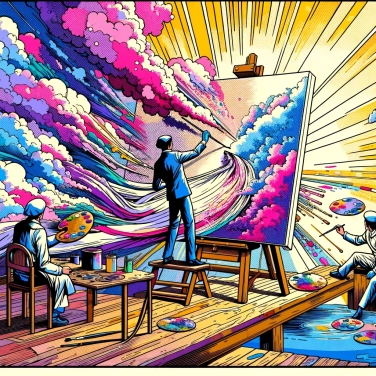The marouflage technique is used to fix paintings on rigid supports such as wood or metal because it ensures a strong and durable adhesion between the paint and the support, thus avoiding any risk of detachment or degradation of the artwork.

Marouflage is a method that involves gluing a painting canvas onto a rigid support, such as wood or metal, using a special adhesive called maroufle. This technique allows the artwork to be well-stretched and remain flat, avoiding distortions, wrinkles, or cracks. The principle is simple: a consistent layer of adhesive is applied between the canvas and the support, which is then pressed firmly to ensure uniform adhesion. Once dry, the result is very stable and durable over time.
Painting can change over time, crack, and deteriorate, particularly due to fluctuations in humidity and temperature. Mounting addresses these issues by firmly adhering the canvas to a rigid support (wood, metal), which provides good stability and prevents deformation. With this method, the painting remains flat, solid, and well-protected. It prevents the surface from warping, cracking, or losing its original colors. Mounting also prevents premature aging, making it a very useful technique if one wants to keep the artwork in good condition for a long time, regardless of external conditions.
Marouflage provides a clear gain in sturdiness to the artwork: a painting adhered to a rigid panel like metal or wood withstands vibrations, shocks, and deformations better. It prevents the paint from cracking or flaking over time. Additionally, marouflage forms a protective layer, acting like a sort of shield that limits the effects of humidity and temperature fluctuations on fragile paintings. This is especially valuable when a piece requires long-term preservation. Essentially, it’s a true ally for keeping works intact that can endure through generations without showing signs of distress.
The technique of marouflage has enabled many famous achievements, especially during the Renaissance, when some great masters like Leonardo da Vinci fixed paintings on wooden panels to gain more strength or facilitate transportation. Much later, painted or printed advertising posters, particularly during the Art Nouveau period, were often marouflaged onto metal to ensure resistance and durability against the elements. This process is also regularly found in theatrical or opera sets, where large-scale painted canvases are glued onto rigid wooden panels to achieve solid, easy-to-handle, and reusable backdrops. Famous frescoes in public rooms, such as those adorning the interiors of certain historical French buildings (for example, the decorations of the City Hall in Paris created by Puvis de Chavannes), frequently use marouflage on rigid supports to maintain their brilliance over time.
The mounting also protects the paintings from climatic variations. By securing a canvas onto a rigid support like wood or metal, the risk of deformation or alteration due to moisture or temperature fluctuations is reduced.
Some art restorers use the technique of lining to extend the life of ancient works that have become fragile, as it provides a solid support while minimizing the risk of further damage.
Even the famous painting by Leonardo da Vinci, "The Last Supper," has undergone a similar process to lining during successive restorations throughout its history to enhance its stability and conservation.
The word "marouflage" comes from "maroufle," an ancient term referring to a strong adhesive made from flour and animal glue that was commonly used since the Middle Ages to affix fabrics to various surfaces.
If the technique of marouflage is carried out correctly, by carefully applying the appropriate technical principles and choosing quality materials, the mounted artwork can last for several decades, even centuries, with very high mechanical and structural stability, provided that it is properly maintained.
Here is the translation: "Marouflage is particularly suitable for paintings made on fragile or flexible supports such as canvas or paper. However, it is important to verify that the paint used (oil, acrylic, gouache, etc.) is compatible with the glue and the support chosen for the marouflage."
In addition to wood and metal, it is possible to laminate works onto rigid composite panels such as expanded PVC, lightweight composite materials, or composite aluminum panels, adapting to the needs of long-term conservation, lightweight construction, and dimensional stability.
Yes, when lining old paintings, it is essential to handle the artwork with great care to avoid damaging its surface or paint layer. It is highly recommended to entrust this type of lining to qualified professional restorers who will use specific products and methods that meet the appropriate criteria for conservation and restoration.
The mounting is generally done with traditional animal glues made from skin or bone, or with modern synthetic adhesives such as vinyl or acrylic glues. The choice mainly depends on the technical constraints and the aesthetic goals of the artwork.

No one has answered this quiz yet, be the first!' :-)
Question 1/5